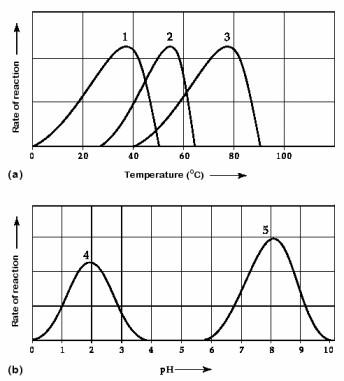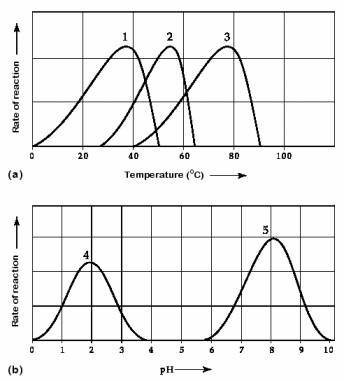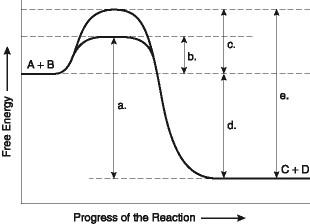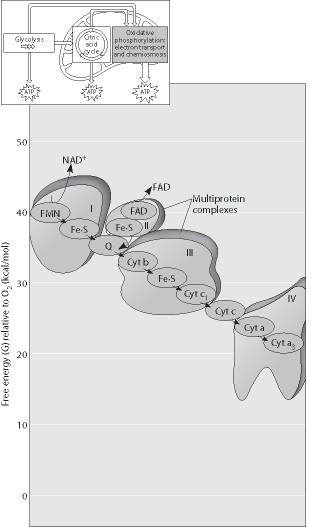Instructions for Side by Side Printing
- Print the notecards
- Fold each page in half along the solid vertical line
- Cut out the notecards by cutting along each horizontal dotted line
- Optional: Glue, tape or staple the ends of each notecard together
Exam 2
front 1 Which of the following is an example of potential rather than kinetic energy? Chapter 8 | back 1 a molecule of glucose |
front 2 Which of the following is true for all exergonic reactions? Chapter 8 | back 2 The reaction proceeds with a net release of free energy. |
front 3 A chemical reaction that has a positive ΔG is best described as Chapter 8 | back 3 endergonic. |
front 4 Reactants capable of interacting to form products in a chemical reaction must first overcome a thermodynamic barrier known as the reaction's Chapter 8 | back 4 activation energy |
front 5 Which of the following statements regarding enzymes is true? Chapter 8 | back 5 Enzymes increase the rate of a reaction by lowering the activation energy barrier. |
front 6 The active site of an enzyme is the region that Chapter 8 | back 6 is involved in the catalytic reaction of the enzyme. |
front 7 When you have a severe fever, what grave consequence may occur if the fever is not controlled? Chapter 8 | back 7 change in the tertiary structure of your enzymes |
front 8 How does a noncompetitive inhibitor decrease the rate of an enzyme reaction? Chapter 8 | back 8 by changing the shape of the enzyme's active site |
front 9 
Activity of various enzymes at various temperatures (a) and at
various pH (b). chapter 8 | back 9 curves 3 and 5 |
front 10 
Activity of various enzymes at various temperatures (a) and at
various pH (b). chapter 8 | back 10 curves 1 and 4 |
front 11  Which of the following terms best describes the forward reaction in the figure? chapter 8 | back 11 exergonic, Δ G < 0 |
front 12  Which of the following represents the ΔG of the reaction in the figure? chapter 8 | back 12 d |
front 13  The following question is based on the reaction A + B ↔ C + D shown in the figure. Which of the following in the figure would be the same in either an enzyme-catalyzed or a noncatalyzed reaction? chapter 8 | back 13 d |
front 14  Which of the following represents the activation energy required for a noncatalyzed reaction in the figure? chapter 8 | back 14 c |
front 15 The mechanism in which the end product of a metabolic pathway inhibits an earlier step in the pathway is most precisely described as chapter 8 | back 15 feedback inhibition. |
front 16 A series of enzymes catalyze the reaction X → Y → Z → A. Product A binds to the enzyme that converts X to Y at a position remote from its active site. This binding decreases the activity of the enzyme. What is substance X? chapter 8 | back 16 a substrate |
front 17 Which of the following clues would tell you if a cell is prokaryotic or eukaryotic? chapter 6 | back 17 whether or not the cell is partitioned by internal membranes |
front 18 Which of the following correctly matches an organelle with its function? chapter 6 | back 18 central vacuole ... storage But remember, plant cells have a central vacuole, whereas most animal cells have several smaller vacuoles located throughout the cytoplasm. |
front 19 All of the following are part of a prokaryotic cell except chapter 6 | back 19 an endoplasmic reticulum. |
front 20 Large numbers of ribosomes are present in cells that specialize in producing which of the following molecules? chapter 6 | back 20 proteins |
front 21 Which one of the following statements about the endomembrane system is correct? chapter 6 | back 21 Proteins that will be secreted from the cell are likely to be found in closed spaces bounded by membranes of the endomembrane system. |
front 22 Hydrolytic enzymes must be segregated and packaged to prevent general destruction of cellular components. Which of the following organelles contains these hydrolytic enzymes in animal cells? chapter 6 | back 22 lysosome |
front 23 Tay-Sachs disease is a human genetic abnormality that results in cells accumulating and becoming clogged with very large, complex, undigested lipids. Which cellular organelle must be involved in this condition? chapter 6 | back 23 the lysosome |
front 24 The liver is involved in detoxification of many poisons and drugs. Which of the following structures is primarily involved in this process and therefore abundant in liver cells? chapter 6 | back 24 smooth ER |
front 25 Which organelle often takes up much of the volume of a plant cell? chapter 6 | back 25 vacuole |
front 26 Mitochondria are found in _____. chapter 6 | back 26 plant and animal cells |
front 27 Which organelle is the primary site of ATP synthesis in eukaryotic cells? chapter 6 | back 27 mitochondrion |
front 28 A cell has the following molecules and structures: enzymes, DNA, ribosomes, plasma membrane, and mitochondria. It could be a cell from chapter 6 | back 28 nearly any eukaryotic organism. |
front 29 Which of the following functions is NOT associated with the cytoskeleton in eukaryotic cells? chapter 6 | back 29 Movement of RNA molecules from the nucleus to the cytoplasm |
front 30 Movement of vesicles within the cell depends on what cellular structures? chapter 6 | back 30 microtubules and motor proteins |
front 31 Property Microtubules (tubulin polymers) Microfilaments (actin filaments) Intermediate filaments Structure Hollow tubes; wall consists of 13 columns of tubulin molecules Two intertwined strands of actin, each a polymer of actin subunits Fibrous proteins supercoiled into thicker cables Diameter 25 nm with 15-nm lumen 7 nm 8-12 nm Main functions Cell motility Cell motility Anchorage The differences among the three categories of cytoskeletal elements outlined in the table above would suggest that each of the following has specialized roles. Which of the following is a correct match? (All three elements are involved in the maintenance of cell shape.) | back 31 microtubules and chromosome movement |
front 32 Cytochalasin D is a drug that prevents actin polymerization. A cell treated with cytochalasin D will still be able to chapter 6 | back 32 move vesicles around the cell. |
front 33 Ions can travel directly from the cytoplasm of one animal cell to the cytoplasm of an adjacent cell through chapter 6 | back 33 gap junctions |
front 34 In the combined processes of glycolysis and cellular respiration, what is consumed and what is produced? chapter 6 | back 34 Glucose is consumed, and carbon dioxide is produced. |
front 35 The molecule that functions as the reducing agent (electron donor) in a redox or oxidation-reduction reaction chapter 9 | back 35 loses electrons and loses potential energy. |
front 36 Which of the following statements describes the results of this
reaction? chapter 9 | back 36 C6H12O6 is oxidized and O2 is reduced. |
front 37 When a glucose molecule loses a hydrogen atom as the result of an oxidation-reduction reaction, the molecule becomes chapter 9 | back 37 oxidized. |
front 38 When a molecule of NAD+ (nicotinamide adenine dinucleotide) gains a hydrogen atom (not a proton), the molecule becomes chapter 9 | back 38 reduced. |
front 39 Where does glycolysis take place in eukaryotic cells? chapter 9 | back 39 cytosol |
front 40 The oxygen consumed during cellular respiration is involved directly in which process or event? chapter 9 | back 40 accepting electrons at the end of the electron transport chain |
front 41 During glycolysis, when each molecule of glucose is catabolized to two molecules of pyruvate, most of the potential energy contained in glucose is chapter 9 | back 41 retained in the two pyruvates. |
front 42 In addition to ATP, what are the end products of glycolysis? chapter 9 | back 42 NADH and pyruvate |
front 43 A glucose molecule is completely broken down to carbon dioxide and water in glycolysis and the citric acid cycle, but together these two processes yield only a few molecules of ATP. What happened to most of the energy that the cell obtains from the oxidation of glucose? chapter 9 | back 43 It is stored in NADH and FADH2 |
front 44 The electrons stripped from glucose in cellular respiration end up in which compound? chapter 9 | back 44 water |
front 45 Where are the proteins of the electron transport chain located? chapter 9 | back 45 mitochondrial inner membrane |
front 46 In cellular respiration, the energy for most ATP synthesis is supplied by chapter 9 | back 46 a proton gradient across a membrane. |
front 47 During aerobic respiration, which of the following directly donates electrons to the electron transport chain at the lowest energy level? chapter 9 | back 47 FADH2 |
front 48 The primary role of oxygen in cellular respiration is to chapter 9 | back 48 act as an acceptor for electrons and hydrogen, forming water. |
front 49 How many oxygen molecules (O2) are required each time a molecule of glucose (C6H12O6) is completely oxidized to carbon dioxide and water via aerobic respiration,? chapter 9 | back 49 6 |
front 50  Which of the protein complexes labeled with Roman numerals in the figure will transfer electrons to O2? chapter 9 | back 50 complex IV |
front 51 Which metabolic pathway is common to both cellular respiration and fermentation? chapter 9 | back 51 glycolysis |
front 52 In the absence of oxygen, yeast cells can obtain energy by fermentation, resulting in the production of chapter 9 | back 52 ATP, CO2, and ethanol (ethyl alcohol). |
front 53 A mutation in yeast makes it unable to convert pyruvate to ethanol. How will this mutation affect these yeast cells? chapter 9 | back 53 The mutant yeast will be unable to grow anaerobically. |
front 54 The photosynthetic membranes are found in the _____ in plant cells. chapter 9 | back 54 chloroplasts |
front 55 The Calvin Cycle Carbon fixation involves the addition of carbon dioxide to _____. | back 55 RuBP |
front 56 The Calvin Cycle After 3-PGA is phosphorylated, it is reduced by _____. | back 56 NADPH |
front 57 The Calvin Cycle How many carbon dioxide molecules must be added to RuBP to make a single molecule of glucose? | back 57 6 |
front 58 The Calvin Cycle In the Calvin cycle, how many ATP molecules are required to regenerate RuBP from five G3P molecules? | back 58 3 |
front 59 Metabolic pathways that release stored energy by breaking down complex molecules are called? chapter 9 | back 59 catabolic pathways |